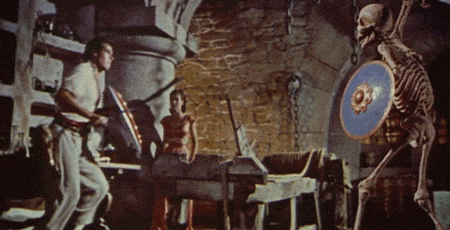I insist, you must listen to my favourite soundtrack from the movie while reading this article. Ah, there we go. Isn't this music catchy and magical? Isn't this movie poster beautiful and magical? Yes, yes, this movie is magical. The 7th voyage of Sinbad (1958) freely adapts the tale from One Thousand and One Nights: Sinbad is blown off course and arrives on a mysterious island, home to Cyclops and other monsters. There, they rescue the magician Sokurah and leave his magic lamp behind. Desperate to get it back, Sokurah forces Sinbad to go back to the island by shrinking the princess, claiming he only misses one ingredient to make the potion that will turn the princess back to her normal size, ingredient which can only be found on the terrible island.

There's no time to breathe in this movie, it is packed with action from start to finish but most of all, it's packed with the beautiful monsters of stop-motion wizard Ray Harryhausen. I think my love for monsters, stop-motion and handmade special effects was born thanks to this specific movie, which left me craving for more adventures with Sinbad, and more monsters made by Harryhausen. Back in the days when special effects were not made with computers, Ray Harryhausen was the master of monster making. The main monster of the movie, the Cyclops, was absolutely groundbreaking for that time, and still is. And the dragon! And the battle between the two, oh my, how they feel like home! I can confidently say that in a new era of impressive CGI achievements that has become
commonplace in practically every blockbuster made in Hollywood today, Harryhausen’s work, while admittedly a bit crude by today’s effects standards,
is exponentially more likeable and tangible on-screen. Contemporary
visual effects remain cold and impersonal for the most part and in
comparison, Harryhausen’s finest moments represent the literal human
touch lacking in today’s sci-fi and fantasy movies. Ray almost always
earned the sense of wonder he set out to achieve. Can you believe it, he developed his own stop-motion animation technique that
allowed for better interaction between live-action subjects and
stop-motion animated models. It remained unnamed until The 7th Voyage of Sinbad,
when it was finally given the name "Dynamation". Although it was not the first film in which
Dynamation was used, The 7th Voyage of Sinbad was the first to use the term in its promotional material, as you can see on the poster. For example, to make my personal favourite monster from the movie, the snake-woman, he combined the images of an actual snake, of the actress, and of a figure of the monster. Harryhausen’s attention to detail was legendary. Sequences that would
last only minutes on-screen took months for him to painstakingly
photograph, working by himself to command each creature’s
movement-by-incremental-movement, imbued with life one frame at a time. It took 11 months to complete the stop-motion effects alone. The results
of that exquisite patience consistently yielded some of the greatest,
naturalistic creatures of the silver screen, and that irreplaceable
talent prompted producer Charles H.Schneer to insure Ray’s hands for no
less than one million dollars, an unheard of precaution at the time,
even by today’s standards when it comes to special effects technicians.
The 7th Voyage of Sinbad sparked a cycle towards fantasy films that lasted
into the Sixties. In the wake of the success of The 7th Voyage of Sinbad, many other films emerged, such as Hercules (1959), The Thief of Baghdad (1961), Jack the Giant Killer (1962), Lancelot and Guinevere (1963), and Ray Harryhausen's own Jason and the Argonauts (1963).
The film also marked a shift in Ray Harryhausen's career. He went from
making primarily science fiction movies to the fantasy films for which
he is best known. Had The 7th Voyage of Sinbad not been a success, it seems certain we wouldn't have Jason and the Argonauts or Clash of the Titans (1981).
The film would also have a lasting impact on various directors through
the years, including Sam Raimi, John Landis, Peter Jackson, Steven
Spielberg, and George Lucas. There should be little wonder that The 7th Voyage of Sinbad should be considered one of the greatest fantasy films of all time. Alongside Jason and the Argonauts,
it is considered Ray Harryhausen's crowning achievement. It isn't a
simple case that it features some of the most spectacular stop motion
effects on film. It also benefited from a strong screenplay and good
performances from its cast; The live action sequences having been shot
in only three weeks and with a budget of only $65 000. The 7th Voyage of Sinbad truly is a triumph in artistry.
As a lifetime lover of the cinema, less than a handful of films truly changed my perspective between before watching the movie, and emerging two hours later as a different person. I don't know which movie gave the same experience to other people of my generation, but I was entranced by this 1958 masterpiece and still am every time I watch it.





No comments:
Post a Comment